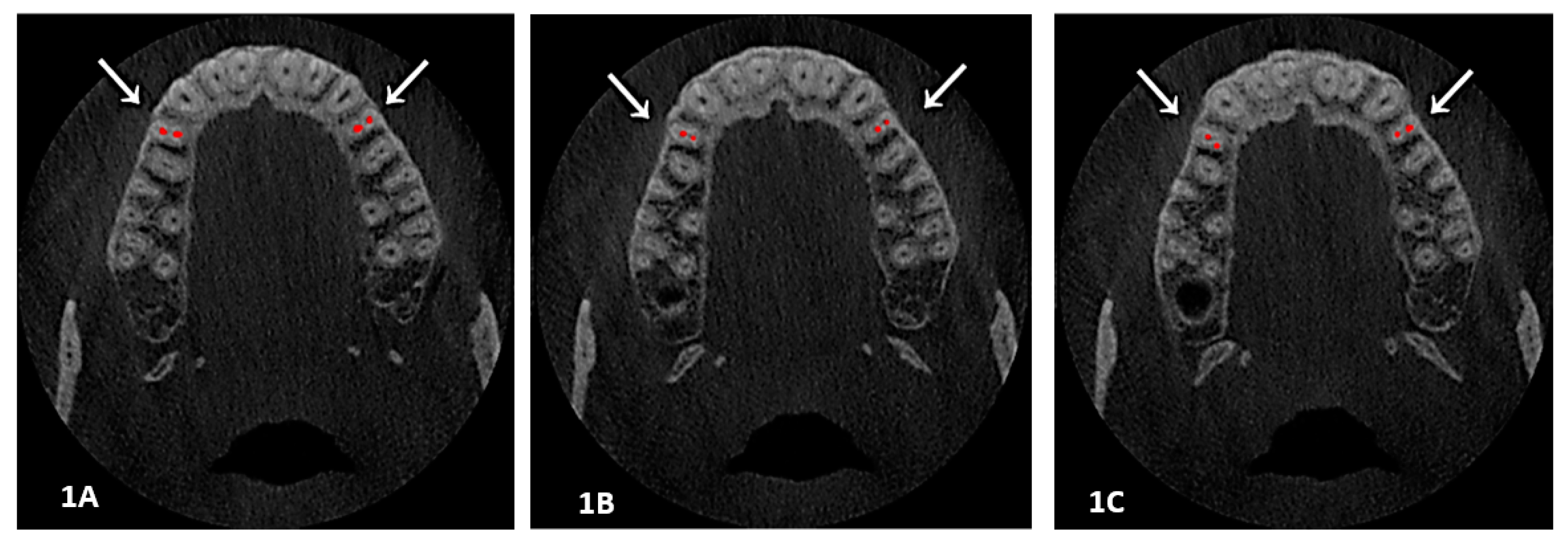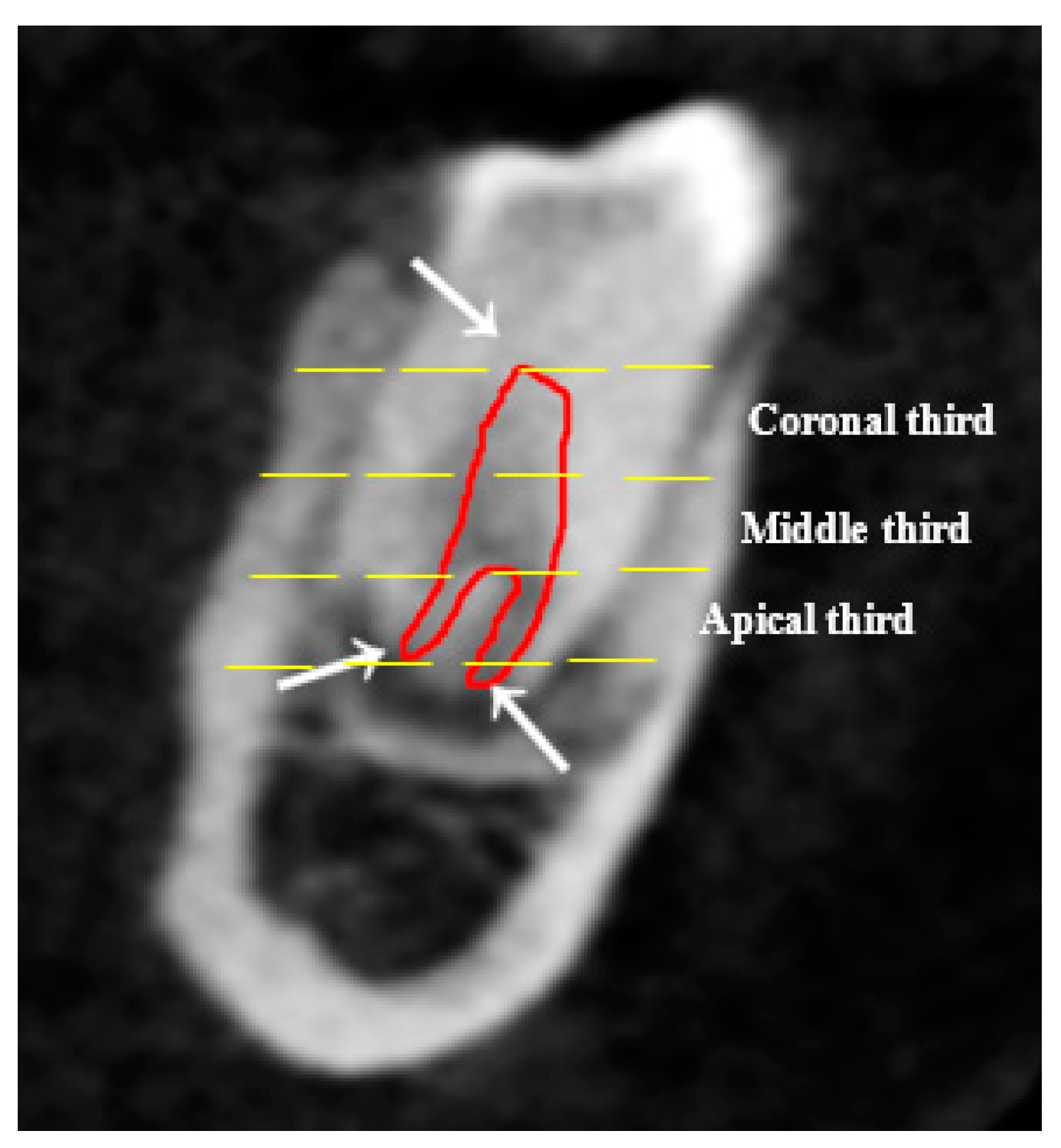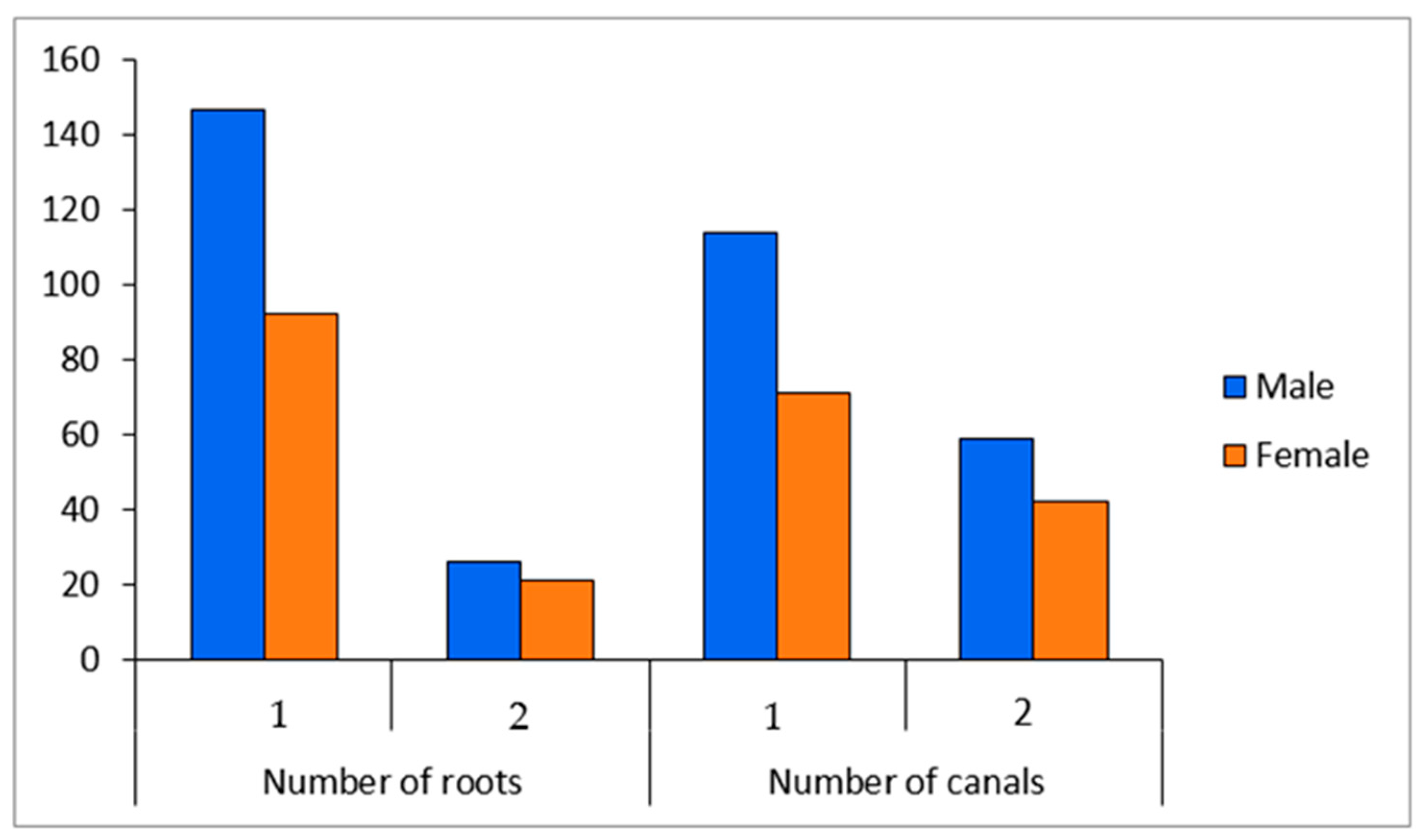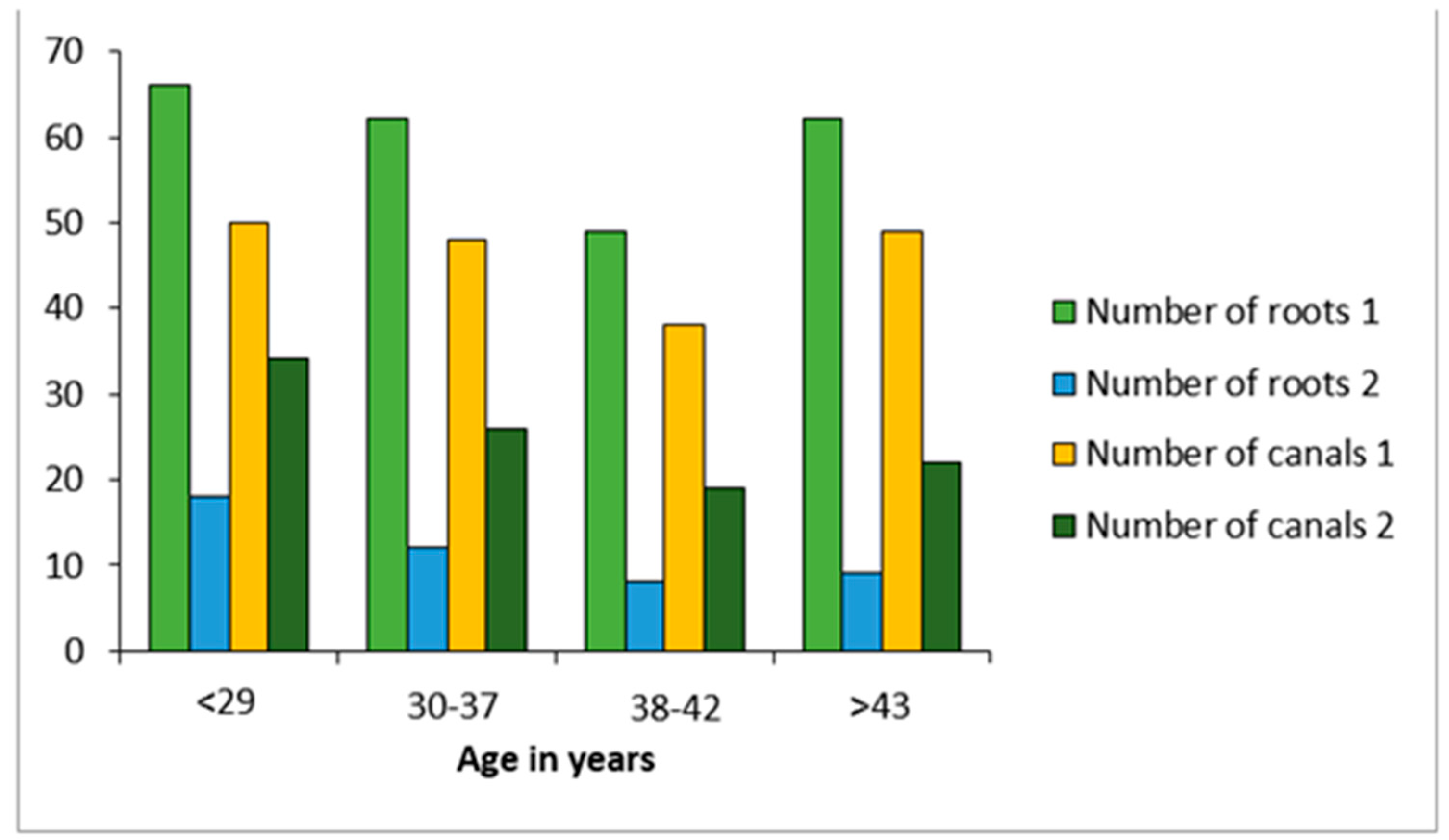Prevalence of Second Root and Root Canal in Mandibular and Maxillary Premolars Based on Two Classification Systems in Sub-Population of Northern Region (Saudi Arabia) Assessed Using Cone Beam Computed Tomography (CBCT): A Retrospective Study
Abstract
1. Introduction
2. Methods
2.1. Inclusion Criteria
2.2. Exclusion Criteria
2.3. Statistical Analysis
3. Results
4. Discussion
5. Conclusions
Author Contributions
Funding
Institutional Review Board Statement
Informed Consent Statement
Data Availability Statement
Conflicts of Interest
List of Abbreviations
References
- Datta, P.; Zahir, S.; Kundu, G.K.; Dutta, K. Different Methods of Studying Root Canal Morphology of Human Tooth: A Review. Bangladesh J. Dent. Res. Educ. 2015, 5, 59–63. [Google Scholar] [CrossRef]
- Shah, N.; Bansal, N.; Logani, A. Recent Advances in Imaging Technologies in Dentistry. World J. Radiol. 2014, 6, 794. [Google Scholar] [CrossRef] [PubMed]
- Bueno, M.R.; Estrela, C.; Azevedo, B.C.; Diogenes, A. Development of a New Cone-Beam Computed Tomography Software for Endodontic Diagnosis. Braz. Dent. J. 2018, 29, 517–529. [Google Scholar] [CrossRef] [PubMed]
- Shukla, S.; Chug, A.; Afrashtehfar, K.I. Role of Cone Beam Computed Tomography in Diagnosis and Treatment Planning in Dentistry: An Update. J. Int. Soc. Prev. Community Dent. 2017, 7, S125. [Google Scholar] [PubMed]
- Mashyakhy, M.; AlTuwaijri, N.; Alessa, R.; Alazzam, N.; Alotaibi, B.; Almutairi, R.; Alroomy, R.; Thota, G.; Melha, A.A.; Alkahtany, M.F.; et al. Anatomical Evaluation of Root and Root Canal Morphology of Permanent Mandibular Dentition among the Saudi Arabian Population: A Systematic Review. Biomed Res. int. 2022, 2022, 2400314. [Google Scholar] [CrossRef]
- Chourasia, H.R.; Boreak, N.; Tarrosh, M.Y.; Mashyakhy, M. Root Canal Morphology of Mandibular First Premolars in Saudi Arabian Southern Region Subpopulation. Saudi Endod. J. 2017, 7, 77. [Google Scholar]
- Weine, F.S.; Healey, H.J.; Gerstein, H.; Evanson, L. Canal Configuration in the Mesiobuccal Root of the Maxillary First Molar and its Endodontic Significance. Oral Surg. Oral Med. Oral Pathol. 1969, 28, 419–425. [Google Scholar] [CrossRef] [PubMed]
- Vertucci, F.J. Root Canal Anatomy of the Human Permanent Teeth. Oral Surg. Oral Med. Oral Pathol. 1984, 58, 589–599. [Google Scholar] [CrossRef]
- Bansal, R.; Hegde, S.; Astekar, M.S. Classification of Root Canal Configurations: A Review and a New Proposal of Nomenclature System for Root Canal Configuration. J. Clin. Diagn. Res. 2018, 12, ZE01–ZE05. [Google Scholar] [CrossRef]
- Zhang, R.; Wang, H.; Tian, Y.Y.; Yu, X.; Hu, T.; Dummer, P.M. Use of Cone-Beam Computed Tomography to Evaluate Root and Canal Morphology of Mandibular Molars in Chinese individuals. Int. Endod. J. 2011, 44, 990–999. [Google Scholar] [CrossRef]
- Silva, E.J.N.L.; Nejaim, Y.; Silva, A.V.; Haiter-Neto, F.; Cohenca, N. Evaluation of Root Canal Configuration of Mandibular Molars in A Brazilian Population by Using Cone-Beam Computed Tomography: An In Vivo Study. J. Endod. 2013, 39, 849–852. [Google Scholar] [CrossRef] [PubMed]
- Kottoor, J.; Albuquerque, D.; Velmurugan, N.D. A New Anatomically Based Nomenclature for the Roots and Root Canals—Part 1: Maxillary Molars. Int. J. Dent. 2012, 2012, 120565. [Google Scholar] [CrossRef]
- Weng, X.-L.; Yu, S.-B.; Zhao, S.-L.; Wang, H.-G.; Mu, T.; Tang, R.-Y.; Zhou, X.-D. Root Canal Morphology of Permanent Maxillary Teeth in the Han Nationality in Chinese Guanzhong Area: A New Modified Root Canal Staining Technique. J. Endod. 2009, 35, 651–656. [Google Scholar] [CrossRef]
- Çalişkan, M.K.; Pehlivan, Y.; Sepetçioğlu, F.; Türkün, M.; Tuncer, S. Ş Root Canal Morphology of Human Permanent Teeth in a Turkish Population. J. Endod. 1995, 21, 200–204. [Google Scholar] [CrossRef] [PubMed]
- Habib, A.A.; Kalaji, M.N. Root Canal Configurations of the First and Second Mandibular Premolars in the Population of North Syria. J. Taibah Univ. Med. Sci. 2015, 10, 391–395. [Google Scholar] [CrossRef]
- Al-Qudah, A.; Awawdeh, L. Root Canal Morphology of Mandibular incisors in a Jordanian Population. Int. Endod. J. 2006, 39, 873–877. [Google Scholar] [CrossRef] [PubMed]
- Karobari, M.I.; Noorani, T.Y.; Halim, M.S.; Ahmed, H.M.A. Root and Canal Morphology of the Anterior Permanent Dentition in Malaysian Population using two Classification Systems: A CBCT Clinical Study. Aust. Endod. J. 2020, 47, 202–216. [Google Scholar] [CrossRef]
- Vertucci, F.; Seeling, A.; Gillis, R. Root Canal Morphology of the Human Maxil-Lary Second Premolar. Oral Surg. Oral Med. Oral Pathol. 1974, 38, 456–464. [Google Scholar] [CrossRef]
- Gulabivala, K.; Aung, T.; Alavi, A.; Ng, Y.L. Root and Canal Morphology of Burmese Mandibular Molars. Int. Endod. J. 2001, 34, 359–370. [Google Scholar] [CrossRef]
- Sert, S.; Bayirli, G.S. Evaluation of the Root Canal Configurations of the Mandibular and Maxillary Permanent Teeth by Gender in the Turkish Population. J. Endod. 2004, 30, 391–398. [Google Scholar] [CrossRef]
- Ahmed HMA, D.P. Advantages and Applications of A New System For Classifying Roots and Canal Systems in Research and Clinical Practice. Eur. Endod. J. 2018, 3, 9–17. [Google Scholar] [CrossRef] [PubMed]
- Ahmed, H.; Versiani, M.; De-Deus, G.; Dummer, P.M.H. A New System for Classifying Root and Root Canal Morphology. Int. Endod. J. 2017, 50, 761–770. [Google Scholar] [CrossRef] [PubMed]
- Bulut, D.G.; Kose, E.; Ozcan, G.; Sekerci, A.E.; Canger, E.M.; Sisman, Y. Evaluation of Root Morphology and Root Canal Configuration of Premolars in the Turkish individuals using Cone Beam Computed Tomography. Eur. J. Dent. 2015, 9, 551–557. [Google Scholar] [CrossRef] [PubMed]
- Algarni, Y.A.; Almufarrij, M.J.; Almoshafi, I.A.; Alhayaza, H.H.; Alghamdi, N.; Baba, S.M. Morphological Variations of Mandibular First Premolar on Cone-Beam Computed Tomography in a Saudi Arabian Sub-Population. Saudi Dent. J. 2021, 33, 150–155. [Google Scholar] [CrossRef]
- Alghamdi, F.T.; Khalil, W.A. Root Canal Morphology and Symmetry of Mandibular Second Premolars using Cone-Beam Computed Tomography. Oral Radiol. 2022, 38, 126–138. [Google Scholar] [CrossRef] [PubMed]
- Ok, E.; Altunsoy, M.; Nur, B.G.; Aglarci, O.S.; Çolak, M.; Güngör, E. A Cone-Beam Computed Tomography Study of Root Canal Morphology of Maxillary and Mandibular Premolars in A Turkish Population. Acta Odontol. Scand. 2014, 72, 701–706. [Google Scholar] [CrossRef] [PubMed]
- Martins, J.N.; Marques, D.; Silva, E.J.N.L.; Caramês, J.; Versiani, M.A. Prevalence Studies On Root Canal Anatomy using Cone-Beam Computed Tomographic Imaging: A Systematic Review. J. Endod. 2019, 45, 372–386. [Google Scholar] [CrossRef] [PubMed]
- Olczak, K.; Pawlicka, H.; Szymański, W. Root form and Canal Anatomy of Maxillary First Premolars: A Cone-Beam Computed Tomography Study. Odontology 2021, 110, 365–375. [Google Scholar] [CrossRef]
- Awawdeh, L.; Abdullah, H.; Al-Qudah, A. Root form and Canal Morphology of Jordanian Maxillary First Premolars. J. Endod. 2008, 34, 956–961. [Google Scholar] [CrossRef] [PubMed]
- Al-Zubaidi, S.M.; Almansour, M.I.; Al Mansour, N.N.; Alshammari, A.S.; Alshammari, A.F.; Altamimi, Y.S.; Madfa, A.A. Assessment of Root Morphology and Canal Configuration of Maxillary Premolars in A Saudi Subpopulation: A Cone-Beam Computed Tomographic Study. Biomed Cent. Oral Health 2021, 21, 397. [Google Scholar] [CrossRef]
- Koçani, F.; Kamberi, B.; Dragusha, E.; Kelmendi, T.; Sejfija, Z. Correlation between Anatomy and Root Canal Topography of First Maxillary Premolar on Kosovar Population. Open J. Stomatol. 2014, 2014, 332–339. [Google Scholar] [CrossRef]
- Rwenyonyi, C.M.; Kutesa, A.; Muwazi, L.; Buwembo, W. Root and Canal Morphology of Maxillary First Premolar Teeth in a Ugandan Population. Open J. Stomatol. 2011, 1, 7–11. [Google Scholar] [CrossRef]
- Elkady, A.M.; Allouba, K. Cone Beam Computed Tomographic Analysis of Root and Canal Morphology of Maxillary Premolars in Saudi Subpopulation. Dental J. 2013, 59, 3429. [Google Scholar]
- Kartal, N.; Özçelik, B.; Cimilli, H. Root Canal Morphology of Maxillary Premolars. J. Endod. 1998, 24, 417–419. [Google Scholar] [CrossRef]
- Neelakantan, P.; Subbarao, C.; Ahuja, R.; Subbarao, C.V. Root and Canal Morphology of indian Maxillary Premolars by a Modified Root Canal Staining Technique. Odontology 2011, 99, 18–21. [Google Scholar] [CrossRef]
- Alfawaz, H.; Alqedairi, A.; Al-Dahman, Y.H.; Al-Jebaly, A.S.; Alnassar, F.A.; Alsubait, S.; Allahem, Z. Evaluation of Root Canal Morphology of Mandibular Premolars in a Saudi Population using Cone Beam Computed Tomography: A Retrospective Study. Saudi Dent. J. 2019, 31, 137–142. [Google Scholar] [CrossRef]
- Thanaruengrong, P.; Kulvitit, S.; Navachinda, M.; Charoenlarp, P. Prevalence of Complex Root Canal Morphology in the Mandibular First and Second Premolars in Thai Population: CBCT Analysis. Biomed Cent. Oral Health 2021, 21, 449. [Google Scholar] [CrossRef]
- Llena, C.; Fernandez, J.; Ortolani, P.S.; Forner, L. Cone-Beam Computed Tomography Analysis of Root and Canal Morphology of Mandibular Premolars in A Spanish Population. Imaging Sci. Dent. 2014, 44, 221–227. [Google Scholar] [CrossRef]
- Kazemipoor, M.; Hajighasemi, A.; Hakimian, R. Gender Difference and Root Canal Morphology in Mandibular Premolars: A Cone-Beam Computed Tomography Study in an Iranian Population. Contemp. Clin. Dent. 2015, 6, 401. [Google Scholar] [CrossRef]
- Cleghorn, B.M.; Christie, W.; Dong, C.C. The Root and Root Canal Morphology of the Human Mandibular First Premolar: A Literature Review. J. Endod. 2007, 33, 509–516. [Google Scholar] [CrossRef]
- Cleghorn, B.M.; Christie, W.; Dong, C.C. The Root and Root Canal Morphology of The Human Mandibular Second Premolar: A Literature Review. J. Endod. 2007, 33, 1031–1037. [Google Scholar] [CrossRef]
- Yu, X.; Guo, B.; Li, K.-Z.; Zhang, R.; Tian, Y.-Y.; Wang, H. Cone-Beam Computed Tomography Study of Root and Canal Morphology of Mandibular Premolars in A Western Chinese Population. Biomed Cent. Med. Imaging 2012, 12, 18. [Google Scholar] [CrossRef] [PubMed]
- Borna, Z.; Rahimi, S.; Shahi, S.; Zand, V. Mandibular Second Premolars with three Root Canals: A Review and 3 Case Reports. Iran. Endod. J. 2011, 6, 179. [Google Scholar] [PubMed]
- Maghfuri, S.; Keylani, H.; Chohan, H.; Dakkam, S.; Atiah, A.; Mashyakhy, M. Evaluation of Root Canal Morphology of Maxillary First Premolars by Cone Beam Computed Tomography in Saudi Arabian Southern Region Subpopulation: An In Vitro Study. Int. J. Dent. 2019, 2019, 2063943. [Google Scholar] [CrossRef] [PubMed]
- Zaatar, E.I.; Al-Kandari, A.M.; Alhomaidah, S.; al-Yasin, I.M. Frequency of Endodontic Treatment in Kuwait: Radiographic Evaluation of 846 Endodontically Treated Teeth. J. Endod. 1997, 23, 453–456. [Google Scholar] [CrossRef] [PubMed]
- Tian, Y.Y.; Guo, B.; Zhang, R.; Yu, X.; Wang, H.; Hu, T.; Dummer, P.M.H. Root and Canal Morphology of Maxillary first Premolars in A Chinese Subpopulation Evaluated using Cone-Beam Computed Tomography. Int. Endod. J. 2012, 45, 996–1003. [Google Scholar] [CrossRef]
- Abella, F.; Teixidó, L.M.; Patel, S.; Sosa, F.; Duran-Sindreu, F.; Roig, M. Cone-Beam Computed Tomography Analysis of the Root Canal Morphology of Maxillary first and Second Premolars in a Spanish Population. J. Endod. 2015, 41, 1241–1247. [Google Scholar] [CrossRef] [PubMed]
- Kottoor, J.; Albuquerque, D.; Velmurugan, N.; Kuruvilla, J. Root Anatomy and Root Canal Configuration of Human Permanent Mandibular Premolars: A Systematic Review. Anat. Res. int. 2013, 2013, 254250. [Google Scholar] [CrossRef]
- Vertucci, F.J. Root Canal Morphology of Mandibular Premolars. J. Am. Dent. Assoc. 1978, 97, 47–50. [Google Scholar] [CrossRef]
- Pineda, F.; Kuttler, Y. Mesiodistal and Buccolingual Roentgenographic investigation of 7275 Root Canals. Oral Surg. Oral Med. Oral Pathol. 1972, 33, 101–110. [Google Scholar] [CrossRef]
- Dou, L.; Li, D.; Xu, T.; Tang, Y.; Yang, D. Root Anatomy and Canal Morphology of Mandibular first Premolars in a Chinese Population. Sci. Rep. 2017, 7, 750. [Google Scholar] [CrossRef] [PubMed]
- Baisden, M.K.; Kulild, J.; Weller, R.N. Root Canal Configuration of the Mandibular First Premolar. J. Endod. 1992, 18, 505–508. [Google Scholar] [CrossRef] [PubMed]
- Liu, N.; Li, X.; Liu, N.; Ye, L.; An, J.; Nie, X.; Liu, L.; Deng, M. A Micro-Computed Tomography Study of the Root Canal Morphology of the Mandibular first Premolar in a Population from Southwestern China. Clin. Oral investig. 2013, 17, 999–1007. [Google Scholar] [CrossRef] [PubMed]
- Özcan, E.; Çolak, H.; Hamidi, M.M. Root and Canal Morphology of Maxillary first Premolars in a Turkish Population. J. Dent. Sci. 2012, 7, 390–394. [Google Scholar] [CrossRef]
- Bellizzi, R.; Hartwell, G. Radiographic Evaluation of Root Canal Anatomy of In Vivo Endodontically Treated Maxillary Premolars. J. Endod. 1985, 11, 37–39. [Google Scholar] [CrossRef]
- Hession, R.W. Endodontic Morphology: II. a Radiographic Analysis. Oral Surg. Oral Med. Oral Pathol. 1977, 44, 610–620. [Google Scholar] [CrossRef]
- Atieh, M.A. Root and Canal Morphology of Maxillary first Premolars in a Saudi Population. J. Contemp. Dent. Pract. 2008, 9, 46–53. [Google Scholar] [CrossRef]
- Saber, S.E.D.M.; Ahmed, M.H.; Obeid, M.; Ahmed, H.M.A. Root and Canal Morphology of Maxillary Premolar teeth in an Egyptian Subpopulation using two Classification Systems: A Cone Beam Computed Tomography Study. Int. Endod. J. 2019, 52, 267–278. [Google Scholar] [CrossRef]
- Buchanan, G.D.; Gamieldien, M.Y.; Tredoux, S.; Vally, Z.I. Root and Canal Configurations of Maxillary Premolars in a South African Subpopulation using Cone Beam Computed Tomography and two Classification Systems. J. Oral Sci. 2020, 62, 93–97. [Google Scholar] [CrossRef]
- Alqedairi, A.; Alfawaz, H.; Al-Dahman, Y.; Alnassar, F.; Al-Jebaly, A.; Alsubait, S. Cone-Beam Computed Tomographic Evaluation of Root Canal Morphology of Maxillary Premolars in a Saudi Population. Biomed Res. int. 2018, 2018, 8170620. [Google Scholar] [CrossRef]
- Al-Zubaidi, S.M.; Almansour, M.I.; Alshammari, A.S.; Al Mansour, N.N.; Alshammari, A.F.; Altamimi, Y.S.; Madfa, A.A. Root and Canal Morphology of Mandibular Premolars in a Saudi Subpopulation: A Cone-Beam Computed Tomography Study. Int. J. Dent. 2022, 2022, 4038909. [Google Scholar] [CrossRef] [PubMed]




| Tooth No. | Number of Roots | Number of Canals | Vertucci Pattern | Ahmed’s Classification Pattern | p-Value | |||||||||||
|---|---|---|---|---|---|---|---|---|---|---|---|---|---|---|---|---|
| Orifice | Canal | Foramen | ||||||||||||||
| 1 | 2 | 1 | 2 | Type I | Type II | Type III | Type IV | Type V | 1 | 2 | Common | Buccal & Palatal | Common | Buccal & Palatal | <0.05 | |
| #14 | 53% | 47% | 26% | 74% | 32% | 68% | 27% | 73% | 27% | 73% | 27% | 73% | ||||
| #15 | 73% | 27% | 42% | 58% | 47% | 47% | 6% | 43% | 57% | 43% | 57% | 43% | 57% | |||
| #24 | 38% | 62% | 18% | 82% | 19% | 81% | 19% | 81% | 19% | 81% | 19% | 81% | ||||
| #25 | 70% | 30% | 24% | 76% | 30% | 6% | 64% | 24% | 76% | 24% | 76% | 24% | 76% | |||
| #34 | 93% | 7% | 76% | 24% | 76% | 2% | 2% | 14% | 6% | 83% | 17% | 81% | 19% | 81% | 19% | |
| #35 | 92% | 8% | 80% | 20% | 80% | 4% | 13% | 3% | 86% | 14% | 82% | 18% | 82% | 18% | ||
| #44 | 89% | 11% | 71% | 29% | 71% | 2% | 17% | 10% | 73% | 27% | 74% | 26% | 74% | 26% | ||
| #45 | 93% | 7% | 82% | 18% | 79% | 4% | 13% | 4% | 85% | 15% | 82% | 18% | 82% | 18% | ||
Disclaimer/Publisher’s Note: The statements, opinions and data contained in all publications are solely those of the individual author(s) and contributor(s) and not of MDPI and/or the editor(s). MDPI and/or the editor(s) disclaim responsibility for any injury to people or property resulting from any ideas, methods, instructions or products referred to in the content. |
© 2023 by the authors. Licensee MDPI, Basel, Switzerland. This article is an open access article distributed under the terms and conditions of the Creative Commons Attribution (CC BY) license (https://creativecommons.org/licenses/by/4.0/).
Share and Cite
Alshammari, S.M.; Ganji, K.K.; Albulayhid, A.A.; Alshammari, A.M.; Alhassan, K.H.R.; Alsirhani, M.A.R. Prevalence of Second Root and Root Canal in Mandibular and Maxillary Premolars Based on Two Classification Systems in Sub-Population of Northern Region (Saudi Arabia) Assessed Using Cone Beam Computed Tomography (CBCT): A Retrospective Study. Diagnostics 2023, 13, 498. https://doi.org/10.3390/diagnostics13030498
Alshammari SM, Ganji KK, Albulayhid AA, Alshammari AM, Alhassan KHR, Alsirhani MAR. Prevalence of Second Root and Root Canal in Mandibular and Maxillary Premolars Based on Two Classification Systems in Sub-Population of Northern Region (Saudi Arabia) Assessed Using Cone Beam Computed Tomography (CBCT): A Retrospective Study. Diagnostics. 2023; 13(3):498. https://doi.org/10.3390/diagnostics13030498
Chicago/Turabian StyleAlshammari, Sultan Meteb, Kiran Kumar Ganji, Amjad Abdulrahman Albulayhid, Akram Mojidea Alshammari, Khalid Hamoud Raja Alhassan, and Munahi Abdullah Rushdallah Alsirhani. 2023. "Prevalence of Second Root and Root Canal in Mandibular and Maxillary Premolars Based on Two Classification Systems in Sub-Population of Northern Region (Saudi Arabia) Assessed Using Cone Beam Computed Tomography (CBCT): A Retrospective Study" Diagnostics 13, no. 3: 498. https://doi.org/10.3390/diagnostics13030498
APA StyleAlshammari, S. M., Ganji, K. K., Albulayhid, A. A., Alshammari, A. M., Alhassan, K. H. R., & Alsirhani, M. A. R. (2023). Prevalence of Second Root and Root Canal in Mandibular and Maxillary Premolars Based on Two Classification Systems in Sub-Population of Northern Region (Saudi Arabia) Assessed Using Cone Beam Computed Tomography (CBCT): A Retrospective Study. Diagnostics, 13(3), 498. https://doi.org/10.3390/diagnostics13030498






